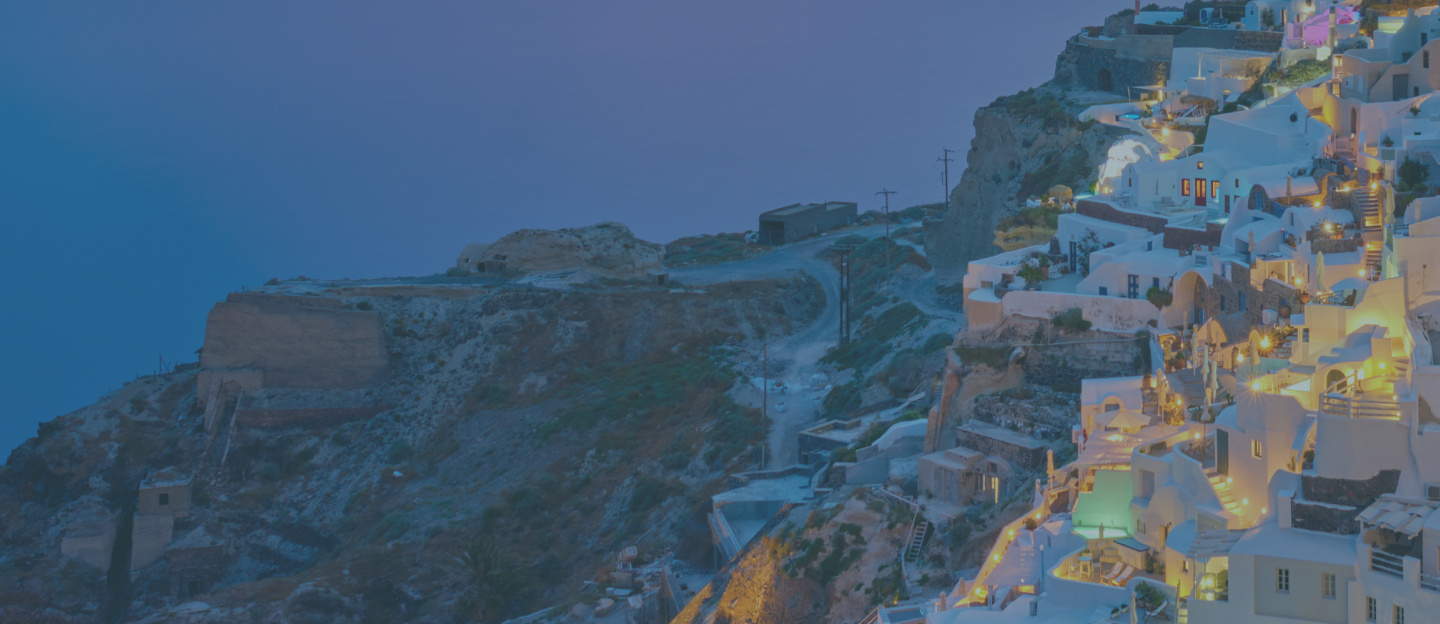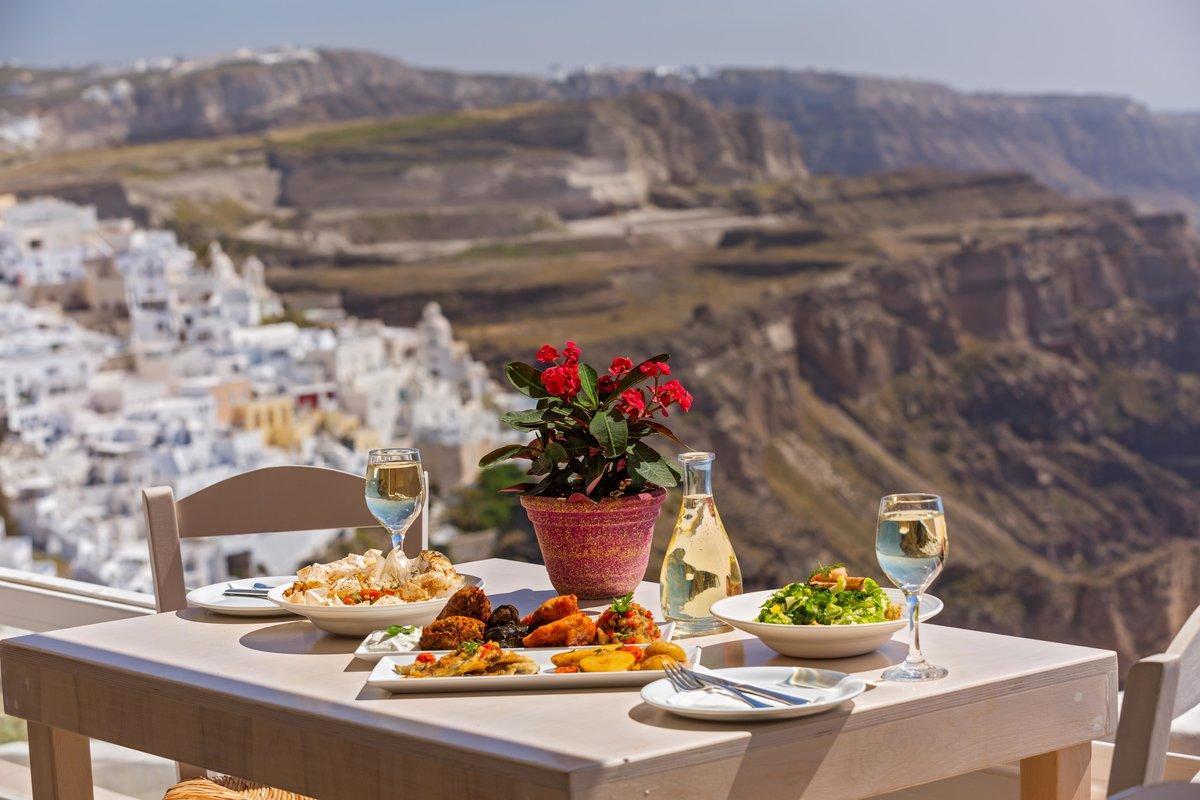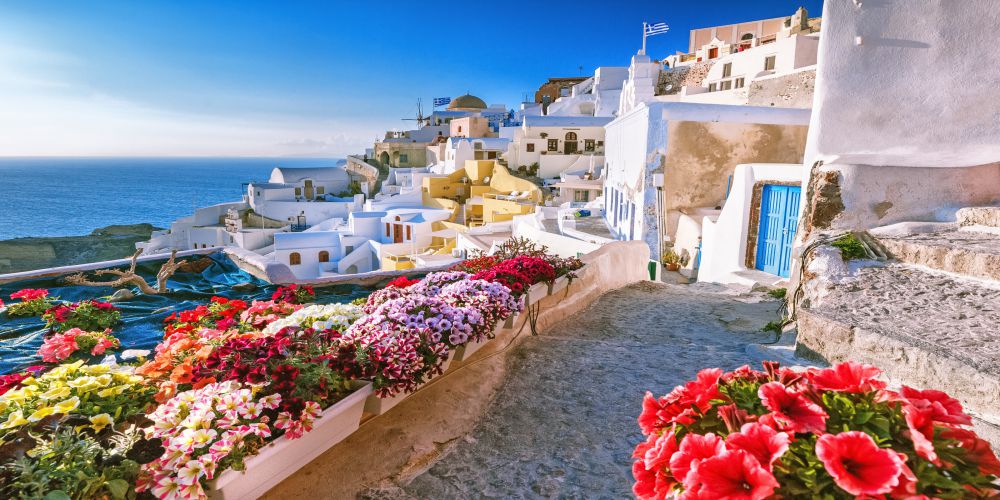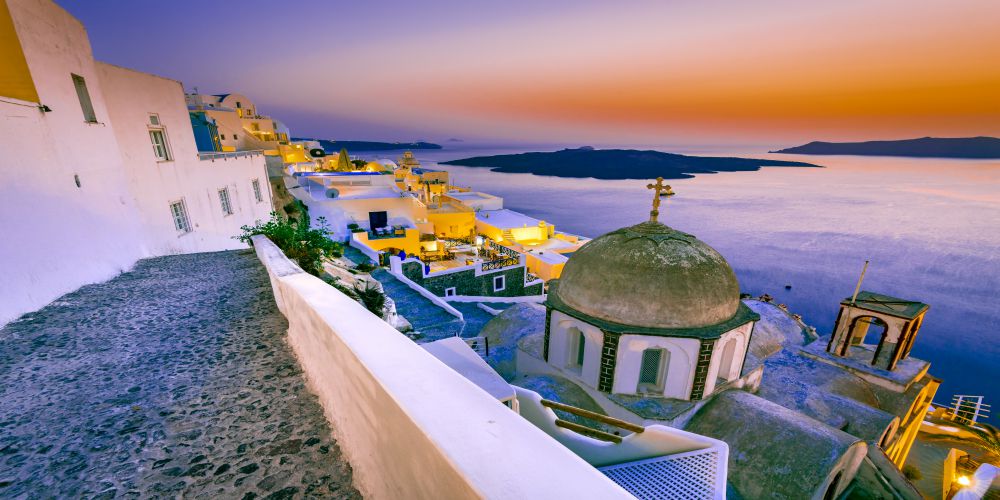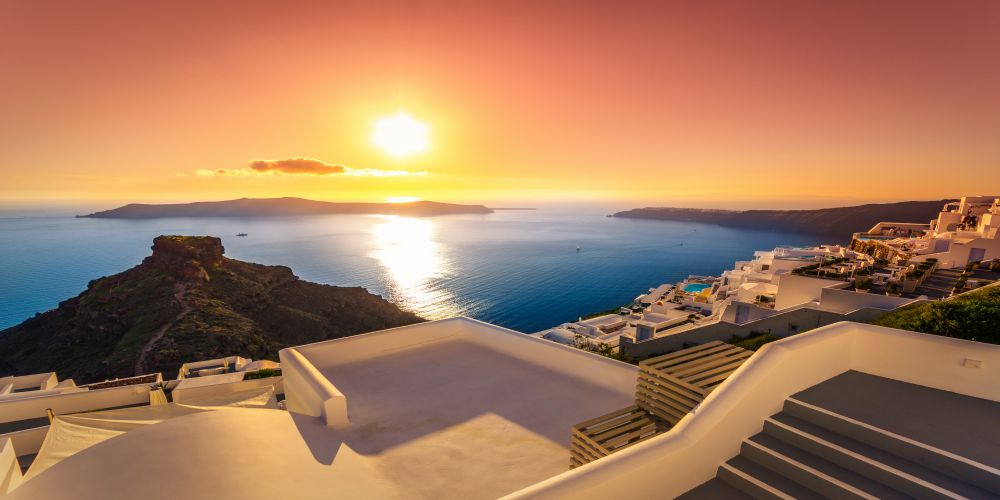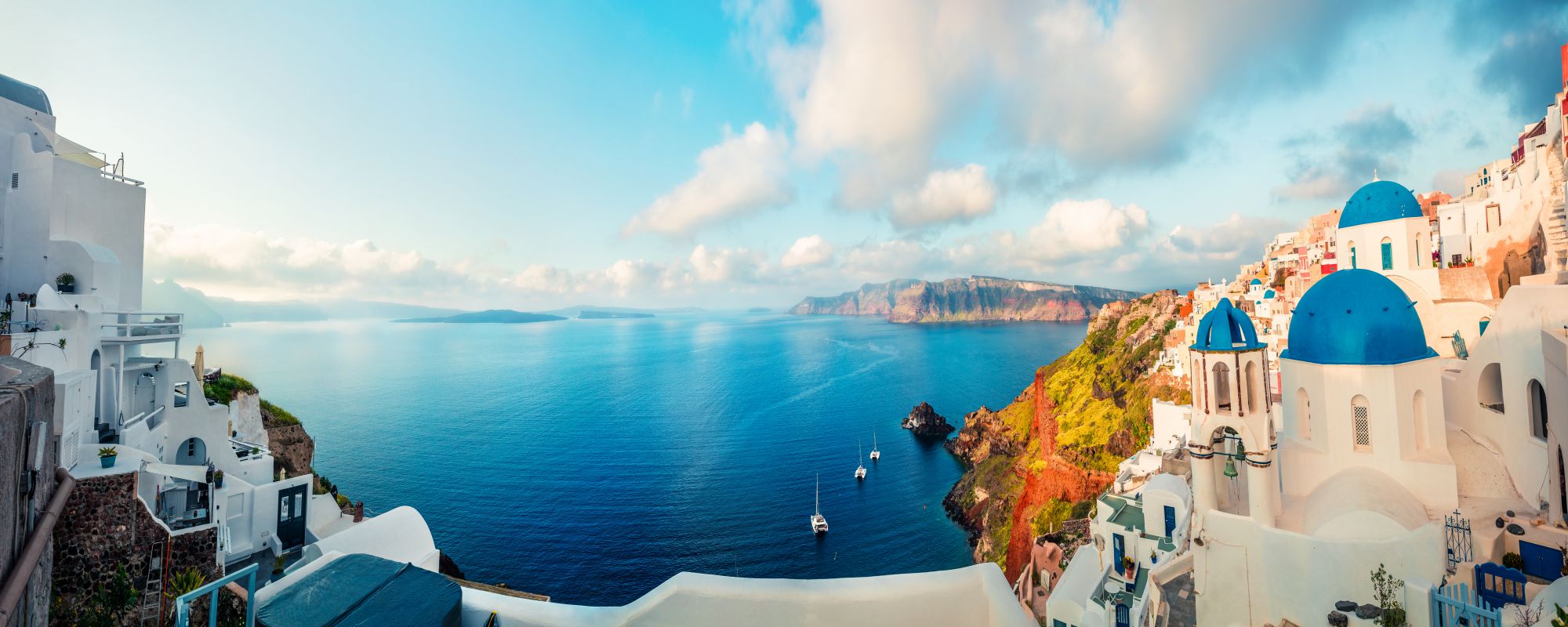
Santorini Caldera: A Majestic Marvel of Volcanic Beauty
Key Takeaways
- The Santorini Caldera is known for its staggering beauty, as the volcanic landscape, its steep cliffs, and deep blue waters create a sight to behold.
- One of the key highlights of the caldera is the mesmerizing sunsets that have gained worldwide recognition.
- The caldera itself is a result of a massive volcanic eruption that occurred thousands of years ago.
- Perched on the caldera's cliffs are the charming settlements of Santorini, such as Fira and Oia, which offer breathtaking Santorini views of the caldera.
The awe-striking Santorini island is, without a doubt, an unprecedented experience for travelers who have never visited it before. Even for those who are familiar with the Greek islands, Santorini, Greece, remains a pleasant surprise due to its unique beauty and otherworldly vibe and views.
One of the most popular attractions and top things to do in Santorini island, all right, let’s admit it, the most popular is the acclaimed Santorini Caldera from where thousands of people every year enjoy magical sunsets that make life seem like a fairytale and their Santorini honeymoon or Santorini elopement like a wish granted.
Here, we will discover the unique Santorini Caldera and learn about its history, secrets, and amazing view of the Caldera that leaves everyone breathless. The things to do in Santorini are truly endless!
What Is The Santorini Caldera?
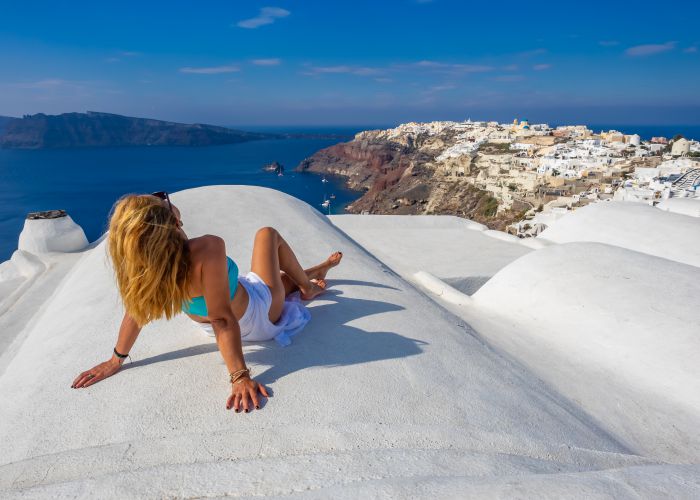
Caldera -from the Spanish word ‘caldera’ meaning ‘cauldron’- is the territorial cavity that is formed when the part of a volcanic cone recedes or when its inner walls gradually erode.
There are many calderas in the world, but the largest and most impressive, in our not-so-humble opinion, is the Santorini Caldera, with a diameter of 16 km.
The Santorini Caldera was formed around 1613 BC after the Minoan eruption. It is one of the most imposing landmarks in Greece. The islands of Santorini, Aspronisi, and Thirasia form its outline. In the center are two small islands, Palea and Nea Kameni islands, which consist of frozen lava. Palea Kameni was created by the eruption that occurred in 47 AD, while Nea Kameni appeared about 1,200 years later.
By 1940, two craters had formed on Nea Kameni, from where fumes still escape. At the eruption of 1950, magma was shaken from them at the height of one and a half kilometers.
During the last eruption and earthquake of 1956 in the caldera, a tsunami was created, which destroyed all the boats that existed in the area as well as almost all the coastal buildings in the wider area.
Santorini History
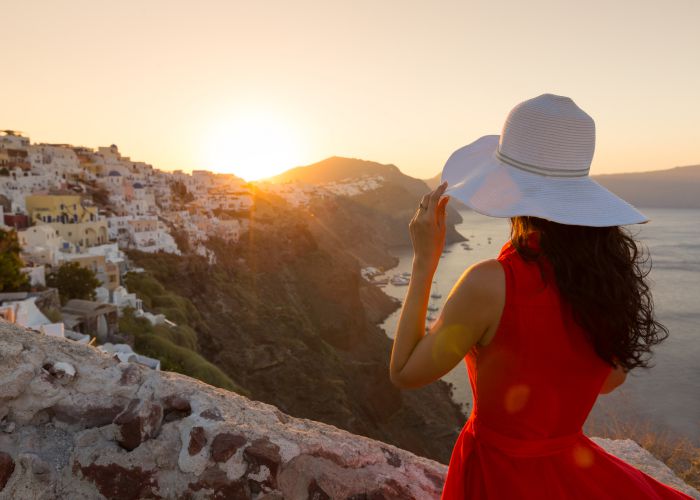
According to Greek Mythology, Euphemus, the son of the god Poseidon, received a pellet of white soil as a gift from Triton. On his return from the Argonaut expedition and after leaving Anafi, he received a warning in the form of lightning and threw the soil into the sea.
From this, the island of Kallisti was created. But according to Herodotus, the Phoenicians were so fascinated by the beauty of Santorini that they settled there and were the ones who gave it the name Kallisti from the ancient word ‘kallisti’, which means the most beautiful.
The later classic name of the island of Thira came from the ancient Spartan Thira, son of the Theban hero Autesia. He was regent of Sparta and responsible for the twin nieces of Proclus and Eurysthenes. When his nieces grew up, Thiras along with other aristocrats left Sparta and settled in Thira.
The name ‘Santorini refers to Agia Irini -or ‘Santa Irini’. The island was named by the Venetians after the 13th century, during their rule on the island. For many years it was believed that this name came from the chapel of St. Irene, built by the Venetians on the island of Thirasia.
Today, however, there are strong indications that the Basilica of Agia Irini at the foot of Mesa Vouno, gave Santorini its name and not the church of Agia Irini in Thirasia.
When the Turks conquered Greece, during the Ottoman Empire, they called the island ‘Dermetzik or Dimertzik,’ meaning small mill, and probably came from the small windmills of the island, which stood out from afar.
The name ‘Thira’ was officially established after the liberation of Greece. However, foreign maps continued to call it "Santa Irina" or "Santorini," which remained with little corruption by the Greeks as Santorini. Even today, the island remains widely known as Santorini both in Greece and abroad.
Santorini in antiquity was called 'Strongyli' because of its circular shape, which changed with the eruption of the volcano in 1650 BC. and the central part of the island sank thus forming the Santorini Caldera.
According to scholars, the eruption of the volcano was an important reason for cutting off the great development of the island until 2000 BC. the Minoan civilization flourished. It is even said that the whole Aegean was darkened, and the waves were 250 m high and 300 km per hour, thus destroying the culture of Crete and Egypt. Some other mythological theories link this catastrophe to the sinking of Atlantis.
"Thira" had declared submission to the Persians and later allied with the Spartans until 426 BC. which came under the rule of the Athenians. Its conquerors were later the Ptolemies and finally the Romans. The Romans initially used the island as a place for exiles, but later helped build the island. The island was often looted and destroyed by pirates.
During the Byzantine period, Thira belonged to the Aegean, then during the Latin occupation in the Duchy of Naxos, until it finally came under the rule of the Venetians. At that time several inhabitants of the island embraced the Catholic doctrine or converted.
In 1537, Thira, following the fate of the other Aegean islands, accepted the raids of Hairedin Barbarossa. Barbarossa liberated Kea, Mykonos, and Thera from Latin rule and forced the island tyrants to recognize the Sultan's sovereignty.
Thira finally fell to the Turks in 1579, with the exception of the castle of Akrotiri, which passed into Turkish hands in 1617. When the Spanish Jew Joseph Nassi died in 1579, to whom the Cyclades had been ceded by the High Gate of the Ottoman Empire, islanders sent an embassy to Sultan Murad III to ask for privileges.
Representatives of Santorini, Greece, also belonged to the envoys of the islands. By definition, issued in 1580, the islands of the Cyclades were granted important privileges, which were renewed in 1628 - 1629 and later. The privileged status helped to organize the system of self-government and to develop commercial activity in them.
Despite the barren soil, the overlapping shield volcanoes, and the devastating earthquakes that hit Santorini, it showed performance in agriculture and shipping. In the early 19th century, the economic strength of the island continued, as did the performance of the navy.
In 1807, according to the navigation carried out by the Portal to meet its needs during the Russo-Turkish war, Thira was forced to send 50 sailors to the Turkish naval base, the same as Mykonos, a fact that reveals the great development of the island's navy.
Growth was also observed during the last years of Ottoman rule in education, while the monastery of Profitis Ilias on the island was one of the most important monastic centers of the Cyclades.
After the liberation of Santorini and its accession to the newly formed Greek state in 1830, the main source of income was trade and shipping. In 1852, Santorini was the second most important trading center after Syros in the Cyclades, trading mainly with Russia, which is the main importer of Santorini wine. Another important source of income was the cultivation of agricultural products and especially the production of wine.
During World War II, Santorini was occupied first by Italians and then by German occupation forces. On July 9, 1956, a magnitude 7.8 earthquake struck near Amorgos, the strongest earthquake in Europe in the 20th century.
The main earthquake, along with a 6.9 magnitude earthquake that followed 12 minutes later, caused extensive damage in Santorini, Astypalea, Anafi, Kalymnos, Leros, Amorgos, and Patmos, 53 deaths, as well as one of the largest tsunamis in the Aegean, with height up to 25 meters. After this event, a large part of the population left the island.
Tourism in Santorini began to develop in the 1960s, culminating in the mid-1980s. Since then, tourism on the island has grown steadily, making Santorini one of the most popular tourist destinations internationally.
The volcano
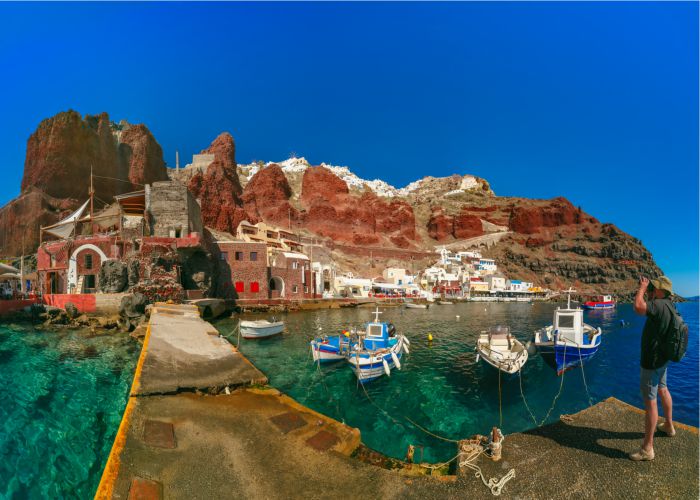
The Santorini volcano is an active volcano and one of the largest underwater active volcanoes in the world. It is perhaps the only volcano whose caldera reaches the sea. The shape of the island as well as the morphology of the soil, are due to the intense volcanic activity.
The oldest volcanic centers are located in the area of Akrotiri, in southwestern Santorini, while 50,000 years later, the volcano of Peristeri was formed between Thirasia and northern Thira, as well as other smaller centers.
The volcanic activity formed a huge cavity, where the sea penetrated and was named the caldera. Its greatest eruption occurred during the Minoan Bronze Age in 1650 BC. The entire center of the then-circular island sank into the sea during the terrible volcanic eruption. The Minoan eruption triggered a tidal wave that wiped out the advanced civilization of Minoan Crete, 70 miles south of Santorini.
During the Minoan eruption of the Santorini volcano, a huge mass of pumice erupted and covered the surface of the sea in most of the surrounding areas of the Aegean, which seems to have drifted to the surface of the sea. The precipitation of the volcano formed the current caldera, where Palea and Nea Kammeni were later formed.
Check out these popular cities on Santorini’s Caldera
Oia
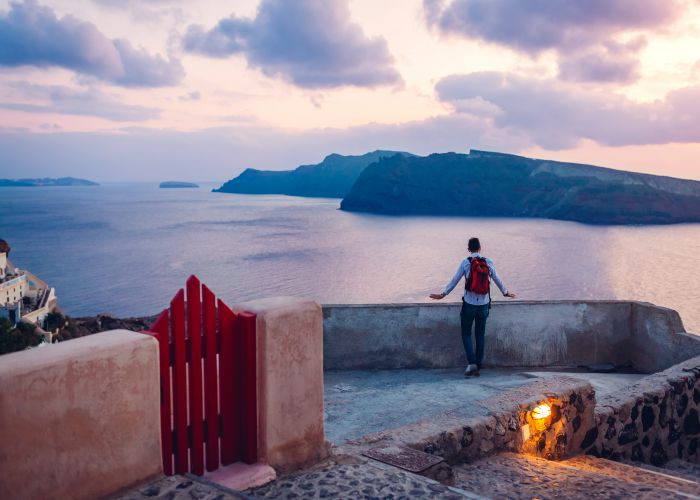
Oia, the first settlement that was declared protected, is without a doubt one of the most photographed places in Greece. Its sunset dresses the Aegean Sea in the most beautiful colors and has been a source of inspiration for inexperienced artists, while its alleys function as magnets that invite you to get lost in their well-hidden secrets.
Oia, which is about 40 minutes drive from Fira, will enchant you because it is truly irresistible. The main road divides it into two areas: one, towards the caldera, has impressive cave buildings, and the other is decorated with captain's houses.
Do not be surprised by the infinite domes that appear on every corner since in Oia, there are more than 60 churches and luxury hotels, some of which are the best Santorini hotels with caldera views. At the end of the settlement is the Castle, with the pieces that have been preserved to offer a unique caldera view but also a charming journey into the past.
The restaurants and café bars of Oia will satisfy you completely, while the minimal suggestions for shopping will put you in a consumer temptation.
Do not forget to go down the 214 steps that separate Oia from the picturesque Ammoudi, where you will enjoy fresh fish and seafood. Also, in Oia is the Maritime Museum, which is worth your visit.
Fira
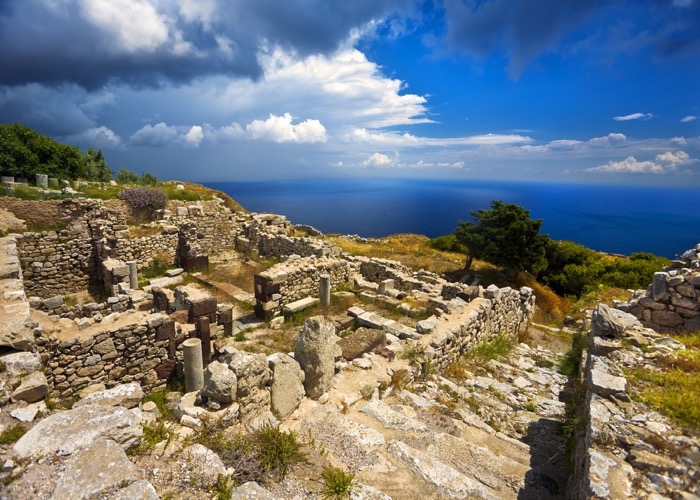
At a distance of 12 km from Oia, the always-busy Fira, the capital of the volcanic island of Santorini, is one of the must-see stops on the island. At a distance of about 260 meters from the sea surface, it seems to hang from the cliff, dressed in white, causing the admiration of every visitor.
The unique location of Fira on the caldera offers stunning views of Nea and Palia Kameni. Crowds flock to the densely populated area of Fira at all hours of the day, if the don't already stay in one of the many hotels in Fira, while the numerous businesses operating in the alleys of the island's capital attract visitors of various interests and of all ages.
Your walk will start from the central square of Theotokopoulos with the many café bars, while, a little further down, a street full of luxury jewelry stores stretches in front of you, giving promises for extravagant experiences!
Indulge in the charm of the beautiful straits of Fira and let your gaze wander to the eerie beauty of the caldera and the Aegean sea. In Fira, you can visit the Archaeological Museum, the Museum of Prehistoric Thera, the Gyzi Palace, and the Santozeum.
To enjoy your acquaintance with Fira to the fullest, you can climb the 588 steps from the Old Port. An alternative is the cable car, which runs daily every 20 minutes, from 07:00 to 22:20.
Tradition lovers can make the journey to and from the Old Port on donkeys! You will enjoy a wonderful view of Fira from Budi, where very interesting events take place every summer.
Firostefani
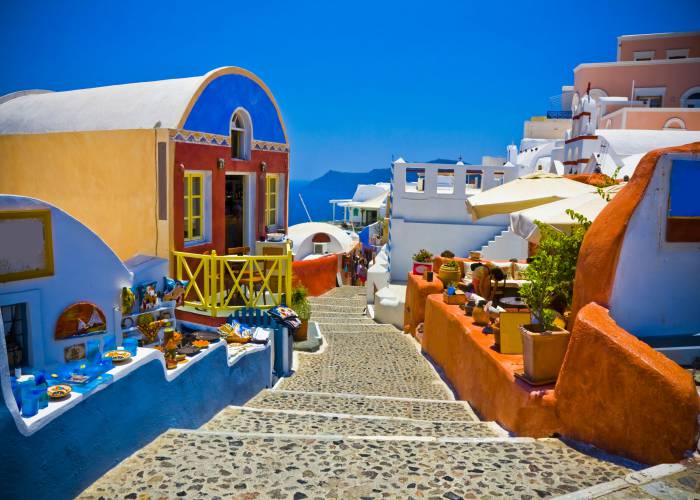
You can reach Firostefani from Fira, following the arch of the caldera and covering a distance of about 10 minutes on foot. Firostefani, which has always been the favorite stop of every visitor to the island, owes its name to the fact that it "crowns" Fira.
The caldera view is simply unbeatable, with the cliff being so steep that many times your heart will beat louder. In Firostefani, you will find several remarkable suggestions for food, in restaurants and taverns that have as their main feature the relaxing atmosphere.
On the way to Imerovigli, you will find the monastery of Agios Nikolaos, built in 1651 by the Gyzi family. It is considered the border between the two settlements, and it is an attraction we suggest you include in your itinerary.
Imerovigli
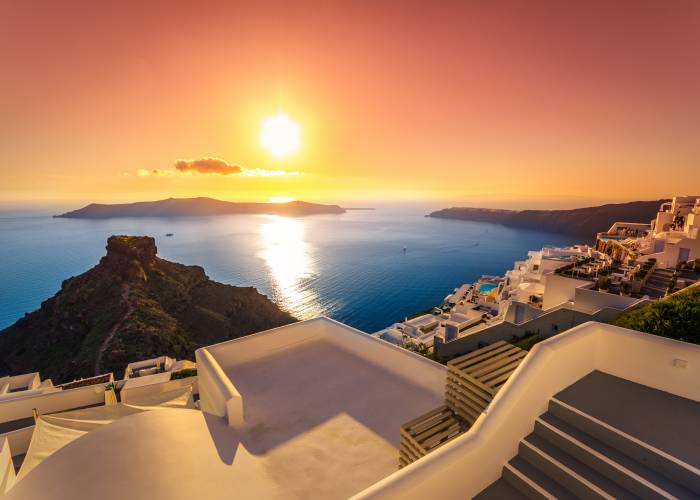
Imerovigli occupies the most privileged position and has the most breathtaking caldera view and view of Thirasia. It is famous for the luxurious Santorini beach hotels that offer its guests a "natural balcony" in the caldera out to the Aegean sea, a calm atmosphere, and a super relaxing landscape, but all hotels in Imerovigli are a sight to behold.
The local restaurants in the central square give you the opportunity to write the ideal epilogue of your day, introducing you in the best way to the gastronomy of Santorini and authentic Greek hospitality.
Visit the church of Panagia Malteza with the imposing wood-carved iconostasis and the icon of the Virgin, which is said to have been found in Malta.
Ammoudi
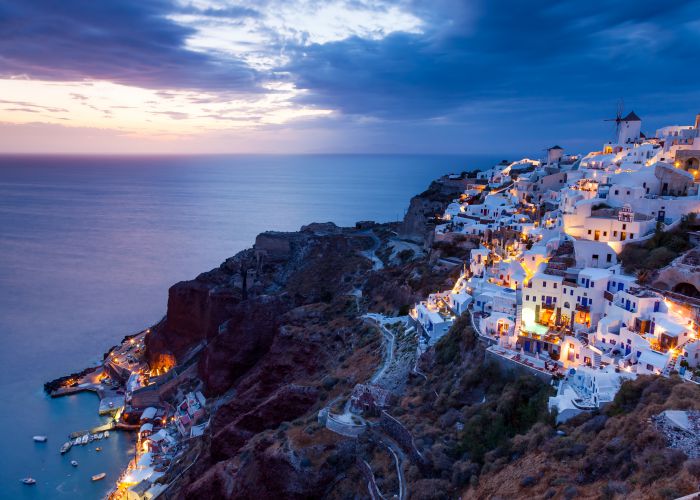
You can reach Ammoudi, a picturesque port that is a must-see of Santorini, going down the 214 steps that separate it from Oia. The commercial port of the 19th century today welcomes mainly lovers of seafood who want to enjoy fresh fish and tasty local delicacies while it is also one of the best beaches in Santorini for lovers of swimming.
A very good choice for food is the traditional tavern ‘Dimitris.’ However, if you want something a little fancier, choose the relatively new restaurant ‘Ammoudi,’ which brought a cosmopolitan air to the area, marrying it perfectly with quality flavors and reasonable prices.
In Ammoudi, you can go either by road or downhill -on foot or with donkeys- 214 steps from Oia.
Akrotiri
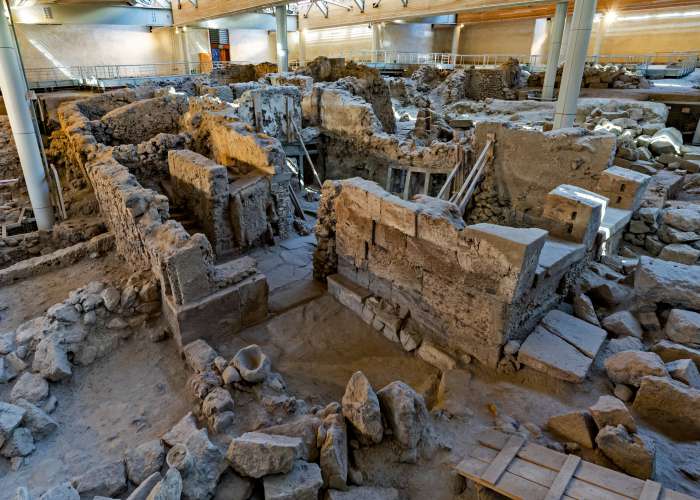
It is the most important archaeological discovery of the Eastern Mediterranean. Akrotiri is a picturesque village in the southwestern part of the island, about 10 km from Fira.
The most important attraction in Akrotiri is the prehistoric settlement, which was first inhabited around 4500 BC. and came to light after the systematic excavations that began in 1967.
The archeological site has been upgraded and acquired a new bioclimatic shelter, attracting thousands of visitors. Do not miss the opportunity to visit one of the most important "historical relics" of Greece -and not only Santorini,’ walking in a city of the past that remains alive.
The archeological site of Akrotiri remains open from April 1st to October 31st. From the port of Akrotiri, you can be transported to nearby beaches, as well as to White Beach, by excursion boats. Also, from here starts a path that leads to Red Beach.
Nea Kameni
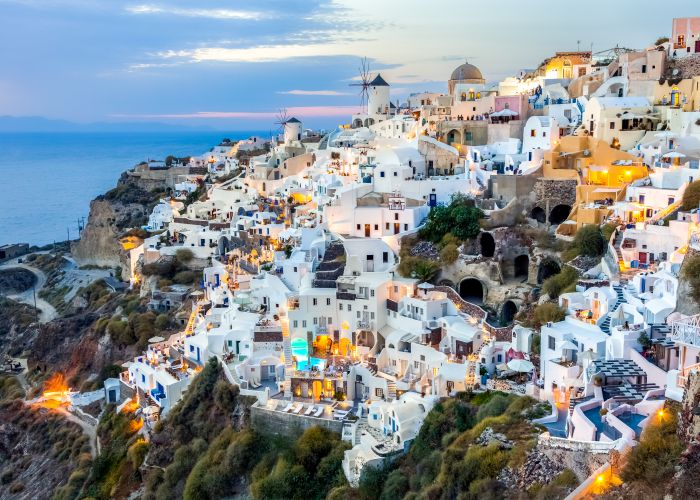
The locals call it a "volcano," visitors make it a priority of their explorations, and the legend adores it. The reason for Nea Kameni, the middle of the three islands of the caldera -Thirasia and Palia Kameni, the other two- that were eyewitnesses of the eruption of the volcano.
In Nea Kameni is the largest crater, called Daphne. Visiting here is truly an inconceivable experience. You will walk around the crater, your gaze will be captured by the color variety of the rocks, your smell will be captured by the smell of sulfur, while all your senses will be awakened by the majestic spectacle.
Emporio
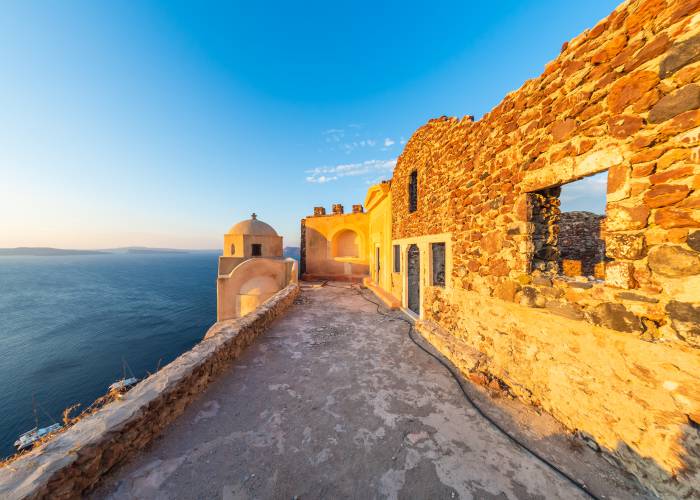
During the Venetian occupation, it was the commercial and economic center of Santorini island. Today it is one of the most interesting villages on the island, especially from an architectural point of view.
Emporio is located in the southern part of Thira, very close to the Santorini beaches of Perivolo and Perissa. Here you will be impressed by the features, houses carved in stone, you will be enchanted by the exploration of the Castle (Mesana), while you will feel intense immersion in Panagia on Kali, located inside the castle.
Do not forget to visit the windmills on the hill of Gavrilos. The landscape, especially on clear nights, is extremely romantic!
How to get there
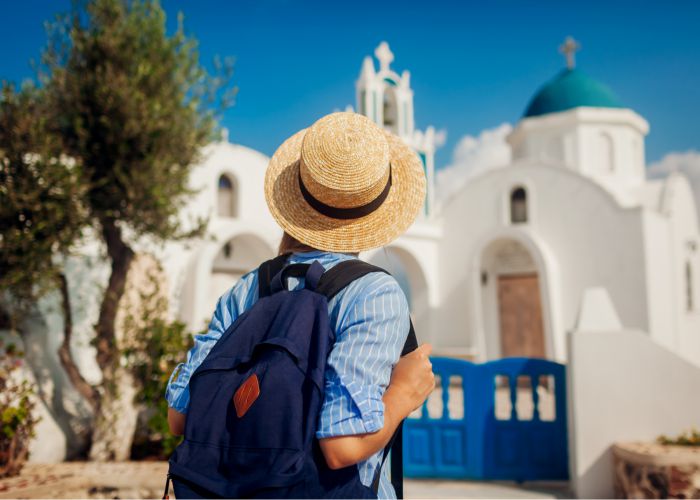
The Santorini Caldera is the center of the world of Santorini island, which you can reach through the ferry port. This makes it easy to access from anywhere on the island.
The closest public transport stop to Santorini Caldera is the ‘Wine Museum,’ which is 147 meters away, and, therefore a 4-minute walk. The ‘Wine Roads’ station is 644 meters away, or a 10-minute walk.
Last but not least, the station of ‘Messaria’ is 1065 meters away, or a 15-minute walk from the caldera. The lines that stop near the caldera are the ones from Fira to Akrotiri and from Fira to Kamari.
The bus from Fira to Vlychada is the first bus that goes to the Santorini Caldera. It stops near 9:18 AM. The last bus that goes to the Caldera is the one from Fira to Akrotiri and it stops near 9:38 PM.
Tours and activities related to the Santorini Caldera
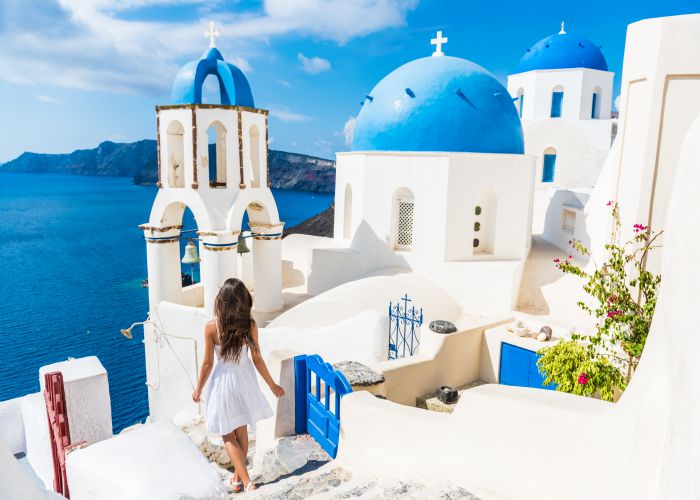
Being a destination dearly beloved by local and international tourists, there are many things one can do, see and visit on the island of Santorini, so spending most of your time in hotel rooms is out of the question during your vacations in Santorini.
It comes as no surprise that there are a number of tours and activities in Santorini related to the Caldera, some more directly than others. You will have an array of choices to explore the culture, history, beauty, beautiful beaches, whitewashed villages, and gastronomy of Santorini island, including its rich wine production.
If you’re a foodie, you can indulge in our Santorini Sunset Wine Experience: Wineries Visit & Wine Tasting. For a unique and luxurious experience that will help you thoroughly enjoy the beauty of the island, you can opt for our Santorini Semi-private Cruise with a meal (Day/Sunset) or our Santorini Private Full-Day Tour With Akrotiri & Wine-Tasting.
Last but not least, if you want your tour to be fully adapted to your needs and desires, you can always book our Bespoke Santorini: Private Customized Tour With Driver-Guide and let us design for you the trip of your dreams!
Visiting Santorini island and admiring its imposing, world-renowned Santorini Caldera and the Santorini volcano should be on everyone’s bucket list. Now is about time to cross Santorini out of yours by booking one of our Greece vacation packages; what are you waiting for?
Frequently Asked Questions
What is the Santorini Caldera?
How was the Santorini Caldera formed?
What can I see and do at the Santorini Caldera?
Is the Santorini Caldera safe to visit?
Can you swim in the Santorini Caldera?
